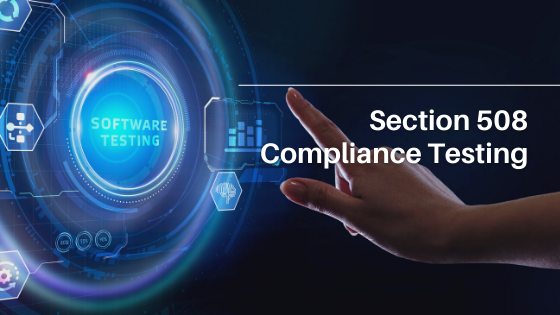The Section 508 website provides a dedicated page on Section 508 compliance testing, including testing guidelines for websites, software, and electronic documents.
Section 508 standard of the Rehabilitation Act 1973 requires all electronic and information technology developed, procured, maintained, or used by the federal government to be accessible to people with disabilities. The Section 508 accessibility standard applies to electronic and information technology procured by the federal government.
Section 508 compliance does not apply to federal agencies alone but also private companies, financial industries, healthcare, legal, or any other organization that does business with a federal agency.
Ensure Government opportunities by creating accurate VPAT for your digital products. VPAT indicates a product’s compliance with Section 508 standards. Check out this blog on What is a VPAT? Should I create a VPAT for my product?
BarrierBreak’s Section 508 testing team assists your organization to ensure that your digital solutions adhere to Section 508 accessibility standards.
The Scope
Section 508, drafted in 1986 as an amendment to the 1973 Rehabilitation Act, was intended to address the needs of disabled workers in the field of electronic information technology at work. It replaced the federal Electronic Information Technology Accessibility and Compliance Act in 1998, which required that all electronic IT products and services provided by Federal agencies be accessible to people with disabilities.
An update of the law which took effect in 2018 aims to align American standards with international accessibility efforts such as the WCAG (Web Content Access Guidelines of the World Wide Web Consortium). The original scope of Section 508 was to make federal information available and accessible to users with disabilities.
Section 508 Refresh
On January 9, 2017, the Access Board issued a definitive rule updating the accessibility requirements under Section 508 of the 1973 Rehabilitation Act known as “Section 508 Refresh”. The Section 508 refresh was to ensure that the information and communication technologies (ICTs) covered by the Act are accessible to people with disabilities.
The Social Security Administration has undertaken to make all its electronic information technologies accessible to disabled people by meeting or exceeding requirements of Section 508. The agency is committed to the comprehensive approach to compliance with 508 to ensure that people with disabilities have access comparable to those without disabilities, and its commitment to accessibility includes the content and online services offered on this website.
If someone with a disability is unable to access a federal agency website, including federal employees with disabilities, Section 508 requires the federal government to provide a means of access. If your website does not comply with the requirements set out in Section 504, you may be subject to legal action or a fine.
BarrierBreak is aware that compliance with Section 508 and related refurbishment of Section 504 is based on testing standards, not a specific set of accessibility tests. The team has worked closely with customers across the globe to implement evaluation procedures that take into account 508 standards, the W3C Digital Accessibility Guidelines and other applicable, policies, and independent development platforms and testing tools.
Section 508 Compliance Testing Checklist
There are some attributes and functions one should check when testing a website for Section 508 compliance. They are as follows:
- Using Alt-Text for every photo, video, logo and non-text element. These are critical because people with visual impairments or low vision can understand and know what’s contained in them. They may be using Assistive Technology like Jaws Screen Reader to read the text on the website.
- There should be sufficient contrast between the background color and information on the webpage. This helps people with low vision read the information on the page.
- Filling out forms shouldn’t be restricted to only mouse. People with disabilities, especially those with motor disabilities should be able to fill such forms using Assistive technology or their keyboards.
- People using Assistive Technology should be able to skip the long list of navigation and sitelinks and jump straight to the content or page they want to read.
Our highly experienced team of accessibility testers not only assist in making your website and other ICT solutions accessible and easily navigable but also makes sure it is ADA and Section 508 compliant.
Write to sales@barrierbreak.com and reach out for further assistance.
